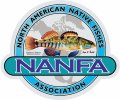Captive Care Notes: Blacktail Chubs (Macrhybopsis, Family Cyprinidae)
Little information is available on the aquarium care of Macrhybopsis minnows, probably because they are difficult to collect. Silver Chub (M. hyostoma), for example, inhabit depths of 10 feet or more and thus are out of the reach of most minnow seines. Sturgeon Chub (M. gelida) and Sicklefin Chub (M. meeki) were once thought to be rare and perhaps in need of federal protection, but that was partly due to a "sampling bias." Biologists who were sampling for them using small seines in shallow water didn't find many; when they switched to benthic trawls in deepwater habitats the two species were found to more abundant and better distributed throughout their range than previously believed. The Shoal Chub (M. hyostoma) often evades capture by apparently diving into the loose, shifting sand that is its preferred habitat; even in a seine it is translucent and easily overlooked unless it wriggles. Perhaps the best time to catch them is at night. And, of course, the sheer size of the Mississippi and Missouri rivers make sampling for Sturgeon and Sicklefin Chub impossible for one or two guys with a minnow seine.
The little that has been reported on the captive maintenance of these interesting minnows indicates that they are hardy, but slow to recognize food when housed in community aquaria with more visually oriented feeders. Sicklefin Chub are particularly timid feeders that should only be kept with themselves in a long, well-aerated tank. Provide a sand substrate and position a powerhead to create a current in the upper half of the water column. David P. Herzog of the Missouri Department of Conservation recommends collecting Sicklefin Chub early in the spring because they tend to be more robust than specimens collected in the summer (pers. comm.). Dave also warns that summer temperatures can be hard on this species when itıs being transportorted.
Spawning has not been observed in aquaria, but eggs from wild-caught Peppered Chub (M. tetranema) have been hatched. Newly hatched larvae repeatedly swim upward in a spiral fashion then sink towards the bottom of the tank. They begin feeding on powdered egg yolk 2-3 days after hatching. Older juveniles aggressively fed on dried food and white worms, but perhaps was not an adequate diet since some of fry developed malformed vertebrae. After about 10 days the young chub were taking most of their food from the bottom, or while it fell downward from the surface. Should Macrhybopsis spawn in your aquarium, it's important to keep the eggs suspended in the water; after all, they spend a day or so floating downstream in the wild. Goldstein, in American Aquarium Fishes, recommends collecting the eggs by swirling a net through the water, and transferring them to a gallon jar with vigorous aeration.
Laboratory experiments show that Speckled Chub (M. aestivalis) never learn to respond visually to food, even after three months in aquaria in water that's crystal clear. Live daphnia remain unnoticed until they touch or swim close to the chubs. Dry food is likewise ignored until it sinks to the bottom and is later found as the chubs forage. Interestingly, when live and dry food are given simultaneously, the chubs consume the dry food first, probably because they sense its presence more readily. Bottrell et al. (1964) noted that their chubs became increasingly secretive as they grew, hiding in plants, behind objects, and in the corners of the tanks. "They seem to cling with their pectoral fins," the researchers wrote, "and are very nervous and easily startled by movement, noise, or light."
